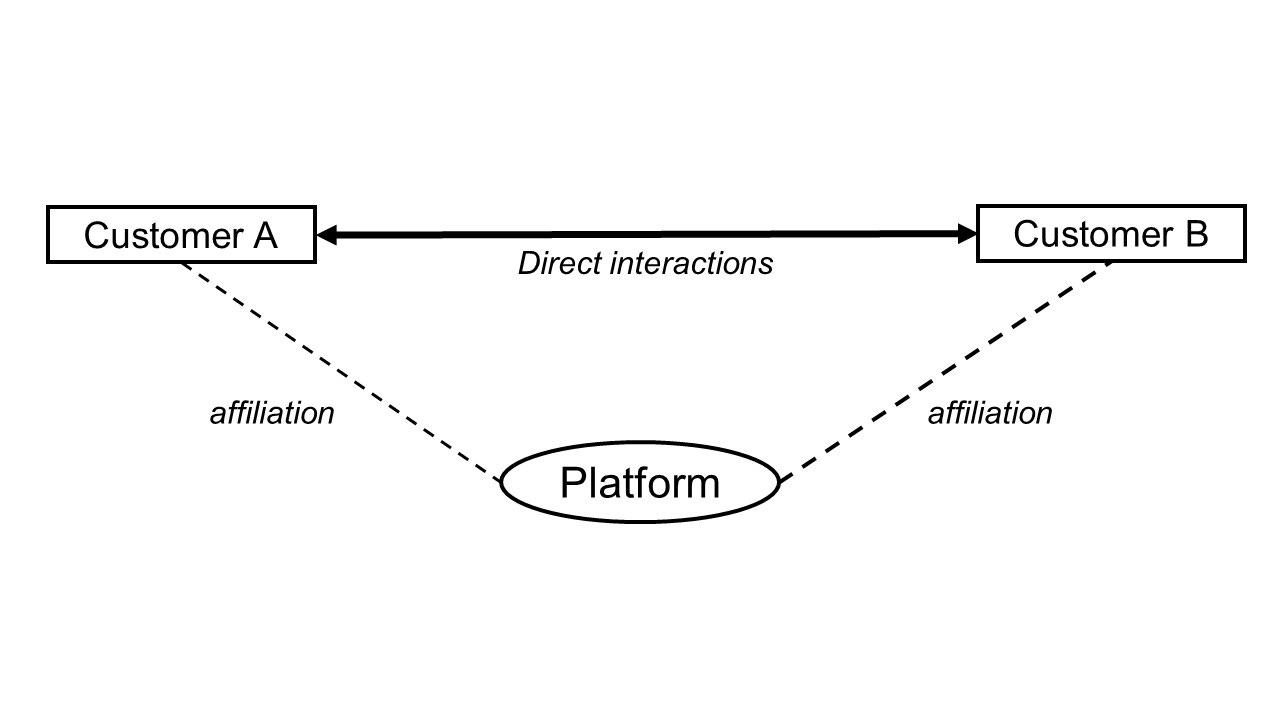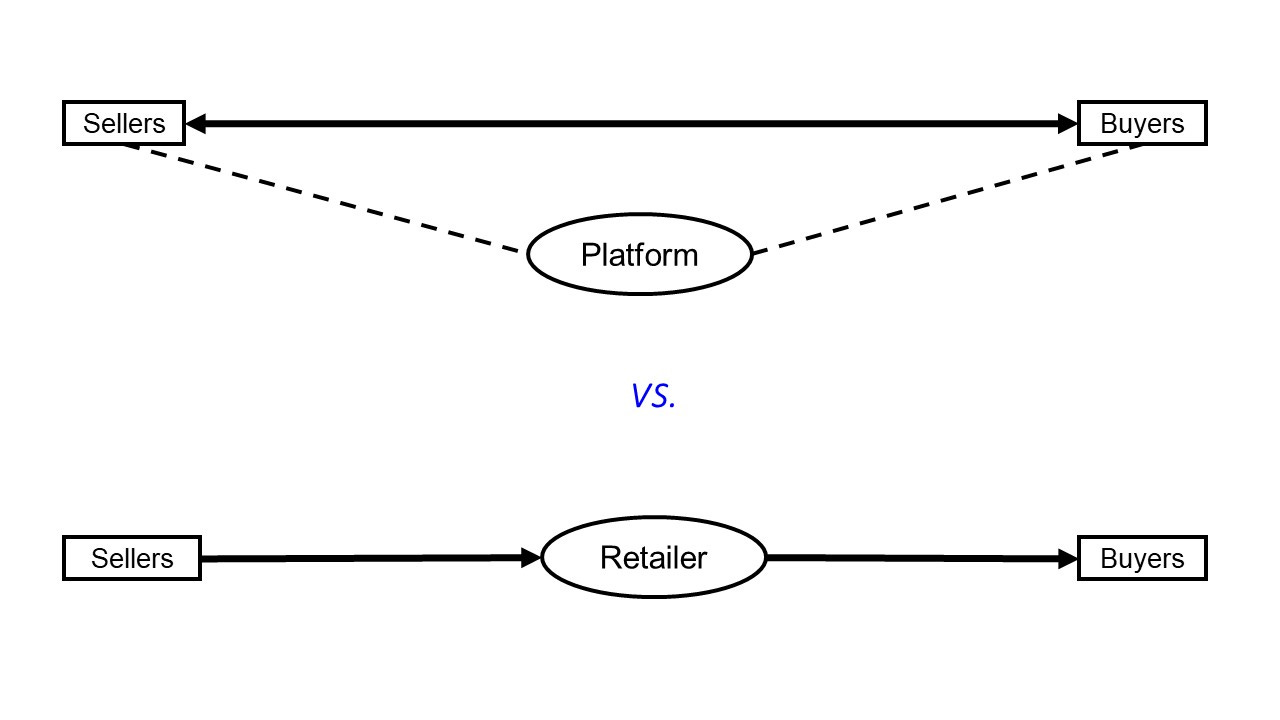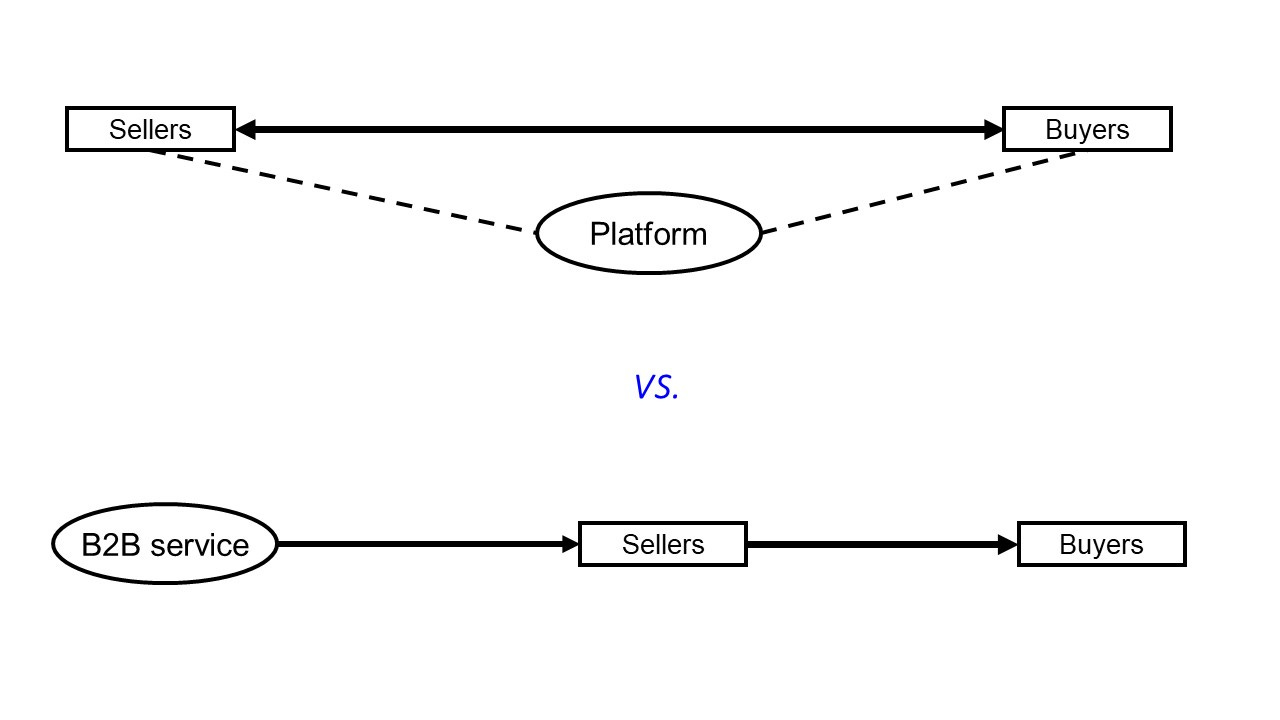What are platform businesses?
Platform businesses enable direct interactions between affiliated customers.
In our posts, we plan to talk a LOT about platforms. It turns out there are many different definitions of platforms floating around. And many commentators use the term “platform” in a very loose way without really defining what they mean. Furthermore, these days, almost every other SaaS firm describes themselves as a platform, perhaps in order to make their competitive positioning and prospects look more appealing to investors.
So we thought it would be useful to make it crystal clear what we mean by platforms, so that our readers can follow our logic in all of our posts.
Here’s our definition:
Platform businesses enable direct interactions between affiliated customers.
To unpack this definition, let’s start with a few obvious examples. eBay is a platform because it enables affiliated buyers and sellers (i.e. those who sign up to eBay) to find each other and trade directly, i.e. on terms that they largely control, without much involvement by eBay. The same is true of thousands of other such online marketplaces, including marketplaces between consumers and merchants (e.g. Tmall), between consumers and developers (e.g. Apple’s App Store), between different businesses (e.g. Fairmarkit, MetalsHub), between local governments and businesses (e.g. DemandStar), between investors and firms (e.g. Kickstarter), etc.
Payment platforms (e.g. PayPal, Visa, Venmo) enable transactions between signed up consumers and/or merchants, although they focus on just enabling the payment component of the transaction, and not on the discovery of merchants. Meanwhile, food delivery platforms like DoorDash, Grubhub and Deliveroo enable discovery of restaurants, payment and delivery.
Of course, platforms are not just limited to facilitating commerce. Dating apps (e.g. Bumble, Hinge, Tinder), social networks (e.g. Snapchat, TikTok, Twitter), messaging and video apps (e.g. Discord, Houseparty, Telegram, WhatsApp, Zoom) are all platforms that enable communications between their users (dating apps and social networks also enable discovery). Computer operating systems like Windows are platforms that enable interactions between users and third-party developers. Similarly, videogame consoles like PlayStation and Xbox are platforms that enable users to play games produced by third-party developers for those consoles. Note that this would be true even if we ignored their respective marketplaces (PlayStation Store and Xbox Marketplace), which enable users to find and purchase games from those third-party developers, and which are also platform businesses in their own right. In fact, up until the launch of the Xbox Store in 2005 and the PlayStation Store in 2006, the major videogame consoles (Nintendo, PlayStation, Xbox) had never had their own marketplaces (users would find and buy games at retailers like Game Stop), yet they were still platforms by our definition.
Although today the overwhelming majority of platforms are digital (and include the most powerful ones), a business need not be digital to qualify as a platform. Shopping malls (e.g. Mall of America, Roppongi Hills) are platforms which enable shoppers to browse, discover and buy from retailers. Similarly, trade fairs (e.g. the Consumer Electronics Show up until 2020) are platforms enabling customers to connect with suppliers. The key is that like their digital counterparts, these real-world platforms are enabling interactions (e.g. transactions) and not manufacturing products or services.
Platforms can be one-sided, i.e. have one type of customer (e.g. Telegram, WhatsApp, Zoom), or they can be multi-sided, i.e. connect two or more distinct types of customers (e.g. eBay connects buyers and sellers, Android connects users, device makers and app developers, Facebook connects users, app developers, advertisers and independent websites that rely on Facebook Connect). Multi-sided platforms are also sometimes referred to in academia as two-sided markets.
Platforms have two important properties which follow directly from their role in enabling interactions between affiliated customers. First, they enjoy network effects: the more customers join the platform, the greater the value for other customers, and therefore the more customers want to join. Second, because most of (or all) the value is created from direct interactions among customers, platforms also have low cost structures (e.g. compare Airbnb with the Hilton chain of hotels). The combination of these two factors creates enormous leverage and is the key reason behind the unparalleled scale, growth and defensibility seen with today’s successful digital platform businesses. As a striking example, consider that in 2019 Craigslist generated over $1 billion in revenues with 50 employees and close to 90% profit margins, despite its design and features hardly changing in 15 years. And not surprisingly, seven of the top ten most valuable public companies in the world today are built around platform businesses.
Just as important as what our definition of platform businesses includes is what it excludes.
First, the requirement of enabling direct interactions excludes pure retailers (online or offline), which buy products from suppliers and then resell them in their own name to buyers.
“Direct interactions” means the customers control the key terms of the transactions, as opposed to the intermediary taking over control of those terms and ownership/inventory of the products involved. Thus, platforms have much lower cost structures and are far more scalable than retailers. Supermarkets are not platforms because they typically take inventory risk and control the prices of the suppliers’ goods, how they are displayed and marketed in the store, and whether to accept returns. Neither is Zappos, because it has full control over the sale of shoes and other items to consumers. This is quite different from eBay, which takes no inventory and gives sellers control over pricing, how their items are displayed, and the terms of shipping, handling and returns. Similarly, in the realm of digital products, Netflix is not a platform because it acquires or produces content, which it then offers to its customers on terms it fully controls (namely, a monthly subscription for streaming access to its entire library). In contrast, YouTube is a platform because it enables third-parties to offer pretty much any video content they want to viewers, to create and manage their own channels, etc. In reality, there is a whole continuum between pure platforms (e.g. Craigslist, eBay, Substack) and pure resellers (e.g. 7-Eleven, Netflix, Zappos). Amazon.com is somewhere in the middle of this continuum: slightly more than 50% of its sales volume comes from 3rd party sellers, whereas the rest is done by Amazon itself as a reseller or first-party producer.
A similar continuum exists for service companies. Platforms like TaskRabbit and Thumbtack allow independent contractors to control the key terms of the relationship with customers. At the other end of the spectrum, companies like HelloAlfred and Honor employ their workers as W-2 employees (which means much higher cost structures), control the prices and branding for their services – so they are not platform businesses. And, as we have explained here, Lyft and Uber sit somewhere in the middle of this continuum: they allow drivers to control their schedules and to work for rival firms, but they do set prices to consumers.
In future posts, we will discuss the strategic question of how firms should consider positioning themselves along the continuum between pure platforms and pure retailers (for products) or employers (for services).
Second, the requirement that all relevant customer types (sides) must be affiliated with the platform excludes businesses that provide B2B services that allow customers to better interact/transact with their customers, but that have no direct connection with these end-customers. By “affiliation” we mean that customers must consciously make a costly decision whether to join the platform. This could be a price that customers pay (e.g., buying a videogame console), expenditure of resources (e.g., spending time and money on learning how to develop applications for Android or iOS), or an opportunity cost (e.g., driving to a shopping mall, signing up and building a profile on a social network).
Consider a few examples of B2B services that are not platforms according to our definition. Airhouse provides delivery and logistics services to enable D2C brands to better deliver goods to their customers, but these brands’ customers have no meaningful affiliation with Airhouse. Similarly, Kea provides restaurants with an AI-powered communication system that makes it easier to take their customers’ phone orders. The restaurants’ customers have no meaningful affiliation with Kea – in fact, they need not even be aware that Kea is powering the ordering system they are using. Amazon Web Services (AWS) provides on-demand cloud computing services via a common IT infrastructure to business customers (among others), in many cases to enable these business users to provide digital services to their own customers. But AWS doesn’t have any connection with its business customers’ customers. Thus, by our definition it wasn’t a platform business until 2012, when it opened up a marketplace between its developer partners and its customers. Because there is no affiliation by the end customer, in each of these examples (Airhouse, Kea, AWS prior to 2012), the B2B services do not involve network effects, which is a crucial property of platform businesses (in our sense of the term) as explained above.
Finally, how does our definition compare to some others? Our definition, which we have laid out in more depth in our 2015 article Multi-sided platforms, is broadly consistent with definitions used in the management and economics fields (indeed, our article has been cited over 1,500 times in other articles on the topic). Various platform consultants are using similar definitions (see here and here).
One other widely cited definition, attributed to Bill Gates, says “A platform is when the economic value of everybody that uses it exceeds the value of the company that creates it. Then it’s a platform.” While this is a property shared by many platforms (given that much of the value creation occurs outside the corresponding firms) and should be a worthy goal for any platform business, it is not very helpful as a definition. It does not help distinguish between retailers and marketplaces, or between B2B service providers and platforms as we have done above. It also seems to us to imply, if interpreted literally, that any product (like a calculator) which creates a lot more value for its users than what the companies that produce it are worth would also be called a platform.
Some tech commentators tend to focus on the fact many platforms involve some common technology or infrastructure that is built upon and used by a large number of different customers, and make this the defining feature of platforms. This seems to stem from the computing field’s use of the word platform, which is an operating system or common infrastructure upon which other software (or APIs) run. Of course, all definitions have pros and cons. But we struggle with this definition because it doesn’t focus attention on what we view as the key attribute that makes platform businesses so powerful – network effects. To see this, note first it doesn’t distinguish platforms that enjoy network effects from firms providing a common infrastructure that don’t (e.g. Amazon marketplace vs. Airhouse). Furthermore, such a definition doesn’t seem to easily accommodate many other firms that are built on network effects like marketplaces or dating sites. Finally, it is not helpful for making the important business model distinctions that we make between retailers and marketplaces.
If you enjoyed reading this, sign up now so you will receive our posts directly in your inbox as they are published.
In the meantime, tell your friends!








Coming from the computing industry, I tend to favor definitions of "platform" that center on a technical interface that standardizes the interactions between modules on either side of that interface, with a platform being a curated collection of said interfaces that makes it easier for those on opposing sides of said interfaces to accomplish a given purpose. Most importantly, the interface enables modules on opposing sides of the interface to innovate independently, thus accelerating the overall rate of innovation of the platform's ecosystem. A great example is Microsoft's Direct3D API, which enabled 3D Graphics Processing Units (GPUs) to innovate independently of game software. This created the first profitable, large-scale niche for GPUs, which led directly to their being used in today's most valuable GPU application: AI.
This definition lends itself to non-computing examples, such as the lens mount (https://en.wikipedia.org/wiki/Lens_mount), the Picatinny Rail (https://en.wikipedia.org/wiki/Picatinny_rail), the tractor's three-point hitch (https://en.wikipedia.org/wiki/Three-point_hitch), and potentially the most valuable physical interface of all time: the shipping container (https://en.wikipedia.org/wiki/Intermodal_container).
The Picatinny Rail is a particularly informative example, as it enabled guns (notably the AR-15) to transition from product to platform, which has made the military's guns much more flexible but which has also complicated the heck out of civilian gun control legislation.
I have been unable find any academic papers in the platform-related literature that study ANY of these non-computing platforms. This is, IMHO, a serious oversight! These examples demonstrate that novel physical interface standards can unlock enormous value, just as digital interfaces can do -- value that could be unlocked in *many* other physical industries, if only the theory and practice that is now known wrt computing platforms were applied to non-computing platforms.
I encourage you to aim a grad student at this research question. 🙂
Hello Andrei and Julian. I have a query. You categorized Xbox and Playstation consoles as platforms. They enable users to play games produced by third-party developers for those consoles. However, both the consoles do not allow the third-party developers to interact with the end users directly, which is a core characteristic of a platform. Both Sony and Microsoft do not allow that direct interaction. Pls educate me how Xbox and Playstation consoles are platforms.